Canon P Rangefinder Camera
A Description of this popular model produced 1959-1961
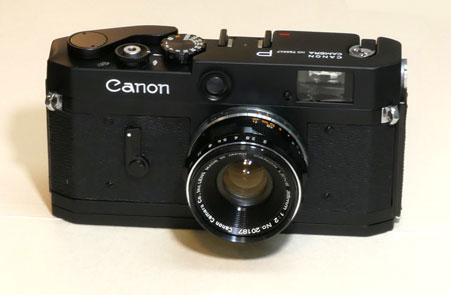
Canon P, sometimes called the 'Populaire', in black with Canon 35mm f2.0 lens
The Canon P of 1958
Recall that as early as 1939 with the introduction of the Canon J that Canon had sought to produce a quality 35mm camera which also had wide appeal to photographers. Canon had an important commercial success with the Canon IVSB in 1953. In developing the Canon P, launched in March 1959 4, Canon finally succeeded in gaining a popular sales success with a quality camera. With sales of nearly 90,000 cameras, the Canon P sold more than twice as many units as any previous Canon camera 1. In fact, it sold far more units than any Nikon rangefinder model, and the total sales of the Canon P alone compared favorably with the total sales of all Nikon rangefinder cameras up to that time (approximately 120,000 cameras.) 6
Canon P Characteristics
The Canon P had a winning combination of attributes:
- a viewfinder that gave a 1:1 lifesize image with parallax-corrected bright line frames for 35mm, 50mm and 100mm lenses in a well illuminated image. This also provided ease of use of the increasingly popular 35mm lens in a life-size, parallax-corrected 35mm viewfinder image - not the case with earlier Nikons or Leicas [Note: The Leica M3 viewfinder was bright, but the image was 0.91x, making shooting with both eyes open not possible. Nikon then in 1955 introduced the Nikon S2 having a 1:1 viewfinder, but without parallax correction. This was followed by the Nikon SP in 1957 with a very sophisticated finder, and the Nikon S3 in 1958, also with a 1:1 finder with 35mm, 50mm, and 105mm lines, but without parallax correction.]
- a single, non-rotating shutter speed dial which allowed easy connection to a light meter mounted to the camera top.
- a new shutter with 1/1000, B and X settings, with electronic flash synchronization speed of 1/55 second, reducing 'ghosting' with flash photography. Also, metal shutter curtains, preventing burning of the shutter curtain.
- lever film winding on the camera top, and a large pop-up film rewind crank.
- a combination of high quality construction with low price - 37,700 Yen with the 50mm f2.8 lens and 52,700 Yen with the 50mm f1.4 4. This was compared with the contemporary Canon VI-L and VI-T priced at 79,800 Yen with f1.8 lens, and the 1957 Nikon SP price of 98,000 Yen with f1.4 lens.
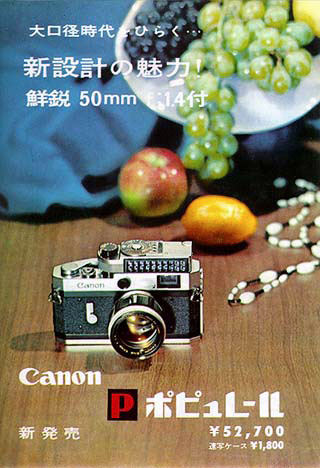
Canon P with the accessory light meter fitted
Sales of the Canon P
As the Canon P was being introduced in March 1959, the Canonflex was soon launched in May 1959. With the fast-growing popularity of the single-lens reflex 35mm camera, the Canonflex was given much attention.
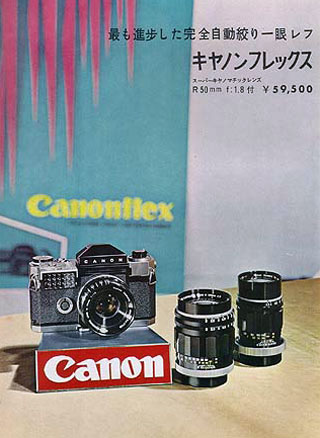
1959 Canonflex advertisement with its accessory light meter attached
The Canonflex, Canon's first single-lens reflex with a new breachlock lens mount and 35mm, 50mm, 100mm and 135mm lenses. 7. However, the Canon P sold more units than the Canonflex plus the Canonflex successors: the Canonflex RP and the Canonflex R2000 taken together.
In this context, the rapid sales success of the Canon P was important for the fortunes of the Canon Camera Company.
Canon P Lenses and Accessories
The Canon P was indeed 'Populaire' selling with the excellent Canon 50mm f1.8 lens for 52,700 Yen. Two other lenses, both also excellent, sold with the Canon P and functioned with the Canon P viewfinder: the 35mm f1.8 and the 100mm f3.5.
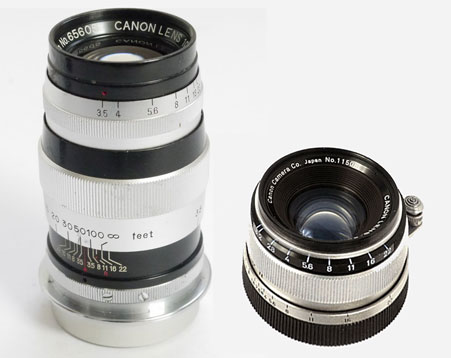
Canon 100mm f3.5 and Canon 35mm f1.8
A popular accessory was the attached Canon selenium cell light meter which directly coupled to the non-rotating shutter speed selector.
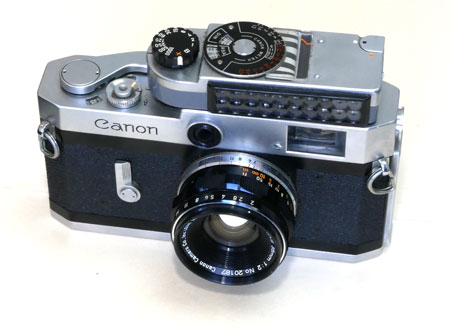
Canon P with attached light meter and with the excellent Canon 35mm f2.0 lens
the light meter had a selector switch for high or low light sensitivity and an accessory booster which was available for low light.
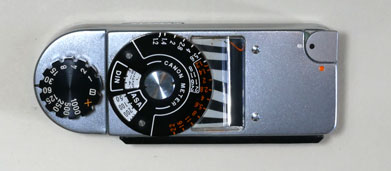
This light meter could also be coupled with the contemporaneous Canon VI-T and Canon VI-L rangefinders. You can read about them by clicking on the links below.
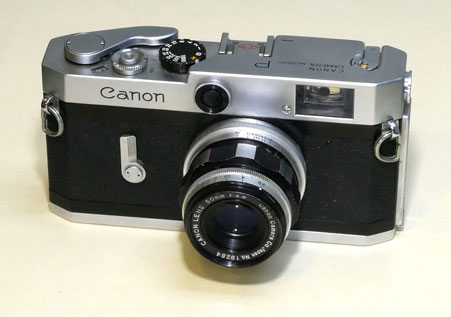
most economical Canon P with 50mm f2.8 lens - sales price only half of top Canon rangefinders and 36% of a Nikon SP
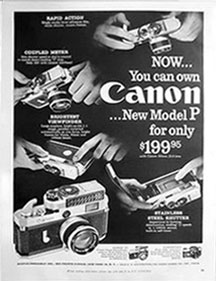
You can click on the links in the table below to consult other pages of the canonrangfinder.org site.
| Navigation: Click Below to Jump to Desired Subject Page | ||
|---|---|---|
| Canon Rangefinder Cameras - 1 | Canon Rangefinder Cameras - 2 | Canon Rangefinder Lenses |
| Canon Hansa | Canon IIAF, IIAX | Development Nikkor 50mm |
| Canon S | Canon IVSB2 | Canon 19mm |
| Canon J | Canon IIS2, IID2, IIF2 | Canon 25mm |
| Canon NS | Canon VT, Canon L2 | Canon 28mm |
| Canon JS | Canon L1, L3 | Canon 35mm |
| Canon S-I | Canon VT Deluxe | Canon 50mm |
| Canon J-II | Canon VL, VL2 | Canon 85mm |
| Canon S-II | Canon VI-L, VI-T | Canon 100mm |
| Canon IIB | Canon P | Canon 135mm |
| Canon III, IIC, IV | Canon 7 | Canon 200mm-1000mm |
| Canon IIIA, IVF, IVS | Canon 7s | Canon Accessories |
| Canon IIA, IID, IID1 | Nicca Rangefinders | Canon Finders |
| Canon IVSB | Leotax Rangefinders | Minolta Rangefinders |
| Canon IIF, IIS | Other Rangefinders | Minolta Lenses |
| Comparison Canon - Nikon Rangefinders | other M39 lenses | |
| Go to canonrangefinder.com home page | ||
Any additions or corrections to these pages would be welcome simply by contacting this site as shown at the foot of this page .
Footnotes:
1 Dechert, Peter. Canon Rangefinder Cameras 1933-1968. Hove Collectors Books. West Sussex, United Kingdom. 1985. ISBN 0-906447-30-5.
Peter Dechert's book is the most important expert source of information regarding Canon Rangefinder Cameras.
2 Kitchingman, Peter. Canon M39 Rangefinder Lenses 1939-1971. A Collector's Guide. Published by Peter Kitchingman. Perth, Australia. 2008. ISBN 978-0-646-48144-9.
Peter Kitchingman's book is the definitive study of the more than three decades of M39 format camera lenses developed for Canon Rangefinder Cameras.
3 Nostalgic Canon Camera Book. 懐かしいキヤノン EI Publishing Co. Ltd. Tokyo, Japan. June 2003.
Peter Kitchingman's book is the definitive study of the more than three decades of M39 format camera lenses developed for Canon Rangefinder Cameras.
4 "Canon Camera Museum" history website. https://global.canon/en/c-museum/history/ published by Canon, Inc. accessed in 2019.
5 Rajner, Hans P. (author), John Wade (editor). Leica Copies. Classic Collections Publications. London, UK. ISBN 13: 9781874485056
Hans P. Rajner's book is an excellently detailed and carefully researched study of camera from around the world which used the Leica M39 lens mount and the same lens to film plane distance.
7 Dechert, Peter. Canon Single Lens Reflex Cameras 1959-1991. Historical Camera Publications. Yakima, Washington. 1992. ISBN 1-879561-04-2.
8 Tomlinson, Shawn M. The Film Photography Book. Lulu Pulbications. 2016. ISBN: 9781365263972
9 Sartorius., Ghester. Identifying Leica Lenses. Classic Camera 19. Tokyo, Japan. 2001. ISBN 4-257-12029-0
10 website http://www.nicovandijk.net/rflensmatrix.htm consulted 2019.
11 O'Reagan, Douglas M. Allied Exploitation of German Science after World War II. Johns Hopkins University Press. Baltimore, Maryland. 2019. ISBN 9781421428888
12 website www.canonrangefinder.servehttp.com consulted 2008.
13 Minolta expert Andrea Aprà has posted information on minoltarangefinders group and other groups and further detailed information by email. (thanks Andrea !)
14 website http://www.collection-appareils.fr/objectifs/ consulted 2019.
15 Small, Marc James. Non-Leitz Leica Thread-Mount Lenses. Wittig Books. Hückelhoven, Germany. 1997. ISBN 3-930359-47-2.
16 the Nikon Corporation website: https://imaging.nikon.com/history/ consulted 2019.
17 p 152. Ray, Sidney F. Photographic Lens ISBN 9780240510323
18 website http://www.rokkorfiles.com/Lens%20History.html accessed 2019
19 Katz, Jerome. The Kardon camera story: a dedication to Peter Kardon, great American patriot & pioneer. SJF Enterprises. New York, New York. 1977.
20 Baird, John. The Japaneese Camera. The History of the Japanese Camera Monograph Collection. Historical Camera Publications. Yakima, Washington. 1990. ISBN 1-879561-02-6.
21 interesting website http://www.topgabacho.jp/Topconclub/Leotax.htm accessed 2019
22 Alexander, Jeffrey Scott. Nikon and the sponsorship of Japan's optical industry by the Imperial Japanese Navy 1923-1945. MA Thesis. University of British Columbia. 2001.
23 Alexander, Jeffrey Scott. Nikon and the sponsorship of Japan's optical industry by the Imperial Japanese Navy 1923-1945. PhD Thesis. University of British Columbia. 2010.
24 Lewis, Gordon, editor. Fujimura, Amy and Fujimura, William, translators. The History of the Japanese Camera. International Museum of Photography at George Eastman House. Tokyo and Rochester. 1991. ISBN 0-935398-17-1.
25 Rotoloni, Robert. Nikon Rangefinder Camera: An Illustrated History Hove Books Ltd. Sussex, UK. 1993. ISBN-13: 978-1874707073
26 Eastland, Jonathan. Dr. Leica M Compendium: Handbook of the Leica-M System Hove Books Ltd. Sussex, UK. 2006. ISBN-13: 9781897802052
If you have any comments or questions about this Canon Rangefinder site, please e-mail me (Larry Huffman) at e-mail address: [email protected]